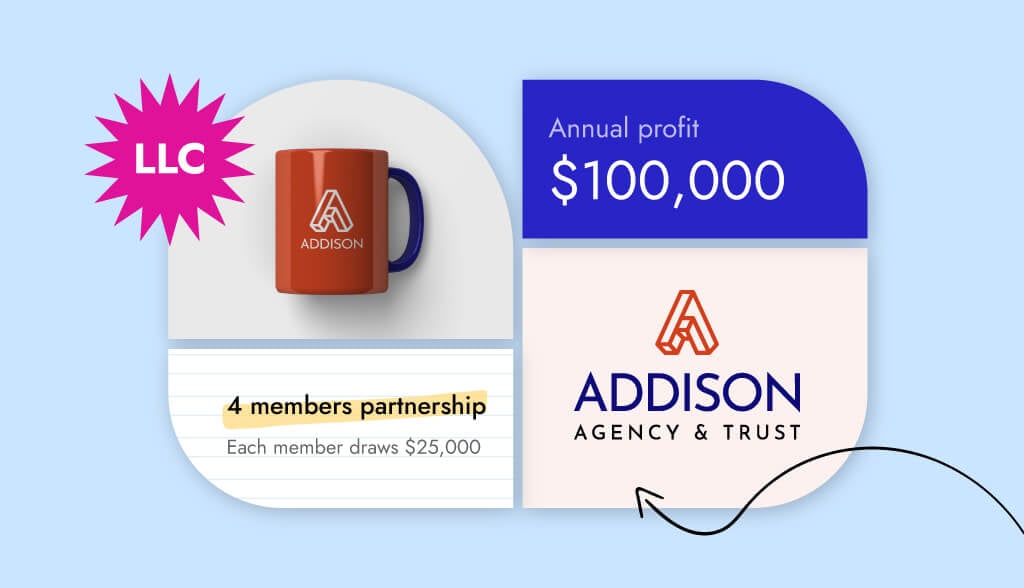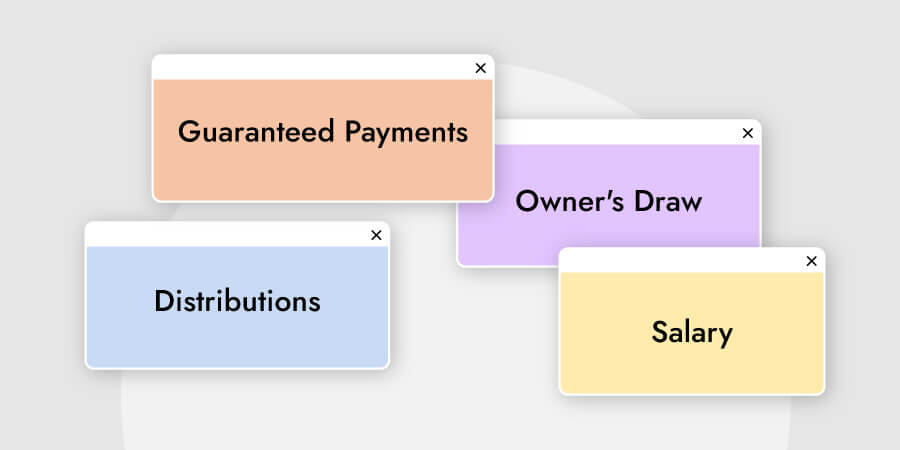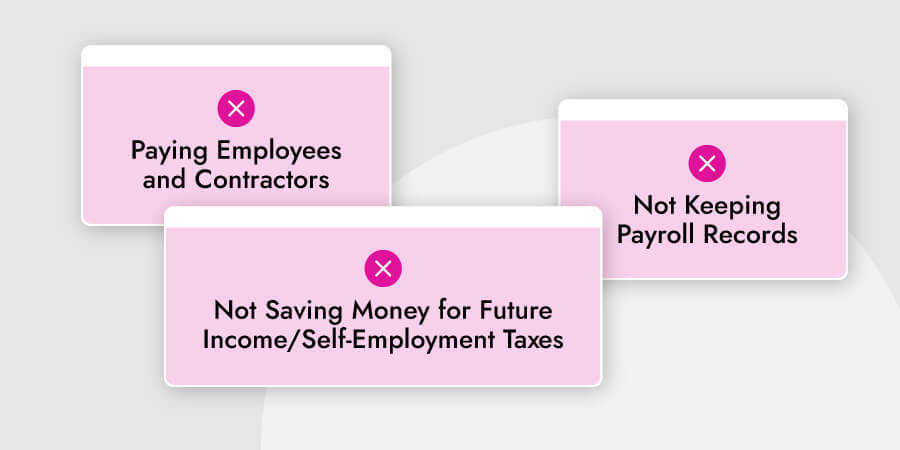
How to pay yourself in an LLC is a question that often leaves new small business owners more than a little confused.
When it comes to earning a salary, you’ve got a few options. Each one depends on your business structure and comes with different tax implications.
Generally, you’ll pay yourself by taking an owner’s draw, which transfers a percentage of your LLC’s income to you as a wage.
The rules differ if you choose to be taxed as a corporation as owners work as employees, take a salary, and receive a dividend (like a bonus), both of which must comply with IRS regulations.
Still confused?
Don’t worry, everyone is at first! We’ll cover everything you need to know about paying yourself in an LLC in this post.
Now, let’s check out your options and find out which is best for you.
A limited liability company (LLC) is a hybrid business structure that combines the best parts of a corporation and a sole proprietorship.
By registering an LLC, you get the limited liability protection of a corporation with the simplified tax system of a sole-proprietorship or partnership (depending on how many people own the LLC).
The Internal Revenue Service (IRS) views an LLC as a disregarded entity (also called a pass-through or flow-through entity). This means you report your business profits and losses on your personal income tax return and you personally pay taxes.
Unless you decide to register your business as a corporate LLC for tax purposes, you’re considered an employee, can take a salary, and both you and the business pay taxes.
And while LLC laws vary by state, the tax requirements are similar.
Types of LLCs include:
The IRS treats an LLC owned by one individual as a sole proprietorship, and it’s the easiest and cheapest way to form an LLC.
An LLC with over one member is treated as a partnership by the IRS unless otherwise requested. The responsibility for debts and taxes is spread between multiple partners.
An LLC can elect to pay taxes as either a C or S corporation. To do so, you must make a formal request to the IRS.

Single-member and multi-member LLC owners pay themselves by taking what’s known as an owner’s draw (I’ll explain what that is in a bit).
Corporation LLC shareholders are employees, so they take a salary and an optional extra dividend payment if profits allow.
Of course, there’s a little more to it than that, so let’s take a closer look:
A single-member LLC is a pass-through entity, which means all your LLC’s profits and losses pass directly to you. Because of that, you can’t take a conventional wage; instead, you take funds from your business, known as an owner’s draw.
An owner’s draw takes a percentage of your LLC’s income and pays it to you as a wage.
An owner’s draw can be a cash payment or a non-cash asset, such as a company computer or car. The frequency and amount of your draw are up to you.
You report your profits and losses by filing a Schedule C IRS Form 1040 along with your personal tax return. The form says sole-proprietor on it, but don’t worry, it’s the right one.
When filing your tax return, always remember that you pay income tax on all your LLC profits, even if you don’t draw them from your company.
Aside from local, state, and federal taxes, you must also pay self-employment taxes on the amount you draw during the tax year.
Self-employment tax is 15.3% and covers your Social Security and Medicare taxes.
You pay them quarterly and determine the amount using Schedule SE (Form 1040 or 1040-SR).
File estimated tax payments using Form 1040-ES or online via the IRS Direct Pay or the Electronic Federal Tax Payment System (EFTPS).
Although the IRS treats a multi-member LLC as a partnership and pass-through entity, owners can choose to be taxed as a corporation and change how they get paid.
Here’s how both options work:
As partnerships are also pass-through entities, members pay themselves by taking an owner’s draw.
A partnership must file an information return to declare its income, profits, losses, deductions, and credits using Form 1065 return of partnership income for tax filing purposes.
A partnership does not pay tax on its income but “passes through” any profits or losses to its partners. Partners must include partnership items on their tax or information returns.
Then each year, the LLC partnership issues members an IRS Schedule K-1, which is used to report their share of income and prepare their personal tax returns.
Members also pay self-employment taxes on their share of drawn profits using the Schedule SE tax form.
And like a single-member LLC, partners must pay income tax on their total percentage share, regardless of whether they draw it as a wage.
How partnership distributions work
Each partner owns a percentage share called their capital account. Their wage reflects their percentage ownership.
For example: Your partnership has 4 members, each owning 25%. The LLC’s annual profit is $100,000, enabling each member to draw $25,000.
But let’s say you only draw half your shares (12.5%); unfortunately, you’ll still owe tax on the complete 25% ($25,000) of your LLC partnership earnings.
However, you’ll only pay self-employment taxes on the 12.5% you drew from the partnership.
Another way to pay yourself in an LLC partnership is to receive a guaranteed payment:
Partners can also receive guaranteed payments from the business. But unlike an owner’s draw, which compensates members for their owned percentage, a guaranteed payment is a business expense used to pay each partner for their time and services.
How guaranteed payments work
Using the same scenario as mentioned before, let’s say that now one partner (Ava) is working longer hours and requires extra compensation.
Each partner owns an equal share and the LLC earns a $120,000 year-end profit.
All 4 partners take $25,000 in owner’s draw throughout the year, leaving $20,000 in the business.
They implement a guaranteed payment of $1,000 per month over 12 months to compensate Ava for the extra hours she worked.
All 4 partners receive $25,000 for their owner’s share, plus Ava gets an extra $12,000. And $8,000 remains in the LLC bank account to cover running costs.
How to report guaranteed payments to IRS
You record a partner’s guaranteed payments on a partner’s Schedule K-1. Add them to Schedule E income tax form 1040, along with any owner’s draw they received.
An LLC can file Form 8832, Entity Classification Election, and elect their business to be treated as a corporation for tax purposes only.
Members in C and S corporations can’t pay themselves by taking an owner’s draw or guaranteed payment because they’re employees. Instead, they receive a salary and take a percentage share of the LLC income in dividends.
A dividend is like a guaranteed payment but with certain IRS restrictions.
Dividends are very attractive to shareholders as they’re exempt from payroll tax. So, the more you’re paid in dividends, the less tax you’ll pay.
Keep in mind that the IRS keeps a close eye on the percentage shareholders receive in dividends and salary (I’ll explain why in just a minute).
When an LLC requests to become a corporation it remains an LLC for all purposes except tax.
S corporation
An S corporation is a pass-through entity. This means that income and losses pass through the corporation to the owners, who pay tax on their personal tax returns.
Members who receive a wage have FICA taxes (Social Security and Medicare tax) withheld from their paycheck.
But members who receive a distribution/dividends don’t pay Social Security and Medicare, resulting in significant savings on payroll taxes.
To register for S corporation tax status, file Form 2553 with the IRS.
An S corporation reports activity on IRS Form 1120S.
C corporation
C corporations pay their income tax at the corporate tax rate, and members also pay income tax on their wages and dividends resulting in double taxation.
As employees of their corporation, income tax and payroll tax are withheld from their earnings.
And similar to an S corporation, dividends are also exempt from payroll taxes.
You apply to be taxed as a C corporation by filing IRS Form 8832.
The business files year-end taxes using Form 1120.
Once you’ve chosen how to pay yourself in an LLC, you have to decide how much to pay yourself.
When first starting out, many LLC owners leave adequate profit in the business to fund future expansion while taking a wage that meets their basic needs.
This is what the IRS defines as “reasonable compensation.” It’s a standard method and works like this:
Start by estimating your LLC’s annual running costs. Include all your current creditors, debts, as well as required reinvestment for annual expansion. And maybe even a rainy-day fund should your immediate cash flow dry up.
The number you arrive at is what your business must earn before you take a salary.
Calculate all your personal annual expenses then add them to your LLC running costs. Now you know what your business must earn to pay you a minimum wage.
If your LLC’s annual profits are more than the running costs and minimum wage, you can increase your salary.
It’s straightforward if you’re taking an owner’s draw or guaranteed payment, as the increased revenue will flow through to your year-end personal tax return.
But if you’re considered an S or C corporation and taking a salary and a dividend, you must account for what the IRS calls reasonable compensation.
For example, let’s say your 4 member corporation turns an annual profit of $400,000. All 4 employees take a $1,000 salary and an additional $99,000 as dividends. You only pay payroll taxes on the $1,000.
In this scenario, the IRS could take your business to court and request to reduce the dividend amount and increase the wage. The end result is you’ll have to pay extra taxes, fines, and late payment fees.
But what does the IRS mean by reasonable compensation?
The IRS defines a reasonable compensation as “the value like enterprises would ordinarily pay for like services under like circumstances.”
You can find the answers to those 3 factors (value, services, and circumstances) by researching government earnings statistics.
Check out online tools such as Glassdoor that provide industry average salaries, enabling you to determine how much to pay yourself as a wage or in dividends.
Of course, the more you receive in dividends, the better, right?
But to ensure you stay on the right side of the IRS, you’ll need the help of an experienced tax accountant to strike the perfect balance.
You can, of course, choose not to take a wage and leave all profits in your LLC business account for future reinvestment and development.
However, suppose your business is a single-member/multi-member/partnership LLC. In that case, you and other members must still pay income tax on your business profits and percentage shares.
But as you haven’t drawn a wage, you won’t have to pay self-employment tax (Social Security and Medicare taxes).

Taxes are pretty complicated.
This complexity sometimes causes business owners to make (sometimes costly) mistakes.
Your best bet is to hire a seasoned tax accountant familiar with county, state, and federal tax laws.
A professional accountant can help you take advantage of legal tax deductions, reduce your tax bill, and ensure your LLC complies with tax laws.
Check out accountancy software like Xero-Best and payroll platforms such as Hourly. They can help you with day-to-day accounting and tax compliance.
All that aside, LLC owners still make mistakes. Here are the 3 most common:
All LLC owners (except those taxed as a corporation) have to make estimated quarterly self-employment tax payments and a year-end income tax payment.
If you don’t pay enough, reserve sufficient funds to amend any shortfall, or pay late, the IRS might charge you a penalty.
And when possible, try to save more than your tax bill in your business account and make estimated quarterly payments before the due date using Form 1040-ES.
If you pay too much, you can always get a tax rebate within 21 days of filing your return.
When I started my first LLC, my accountant gave me a ring folder with several colored sections along with the following advice:
“Always keep a paper trail. Save every receipt no matter how small, log every invoice, bank statement, and tax return. It’ll save you money in the long run.”
While that advice might sound a little over the top, he was right.
Not only for my bank balance but because state and federal laws require an LLC to keep the following accounting records:
Your account must also show every draw you take and paycheck you make, ensuring a clear distinction between personal and business banking.
Because if they don’t and you’re sued, a court might remove your limited liability protection under what’s called “piercing the corporate veil” and hold you liable (under different circumstances).
Never pay yourself, employees, or contractors in cash. Always run everything through your business account using a check or bank transfer. That way, you’ll have a paper trail should you ever be audited.
And as mentioned, use a payroll software system to automate and record every transaction.
While on the subject of employees, you can hire yourself as a contractor, avoid employment taxes, and only pay for services when your business needs them, unlike a full-time employee.
To hire yourself file your IRS Form W-9 with your LLC, which then files IRS Form 1099-MISC.
You’ll also have to pay self-employment tax on the amount your LLC paid you as a contractor and include it in your personal income tax return.
You now know how you pay yourself depends on which type of LLC type you are registered as.
So, if you’ve yet to understand how to form an LLC, that’s your first order of business. Then, consider how you’d like to be paid and then choose the LLC type that offers you the best options.